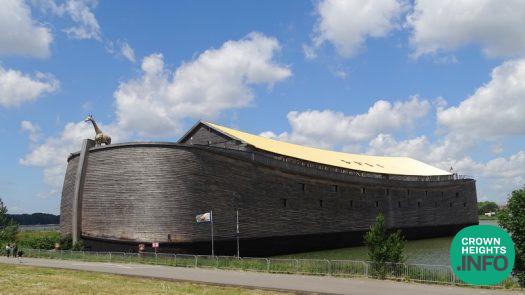
Weekly Dvar Torah: Noach’s Ark, the Tower of Babel, and Redemption
In the time of Noach, G-d saw that human wickedness was overwhelming, with evil intentions constantly consuming their hearts. G-d regretted creating humanity, saying, “I will obliterate humanity that I have created from the face of the earth.” And so, G-d unleashed a great flood to cleanse the world, sparing only Noach, his family, and pairs of animals sheltered in the Ark.
When the flood came, the waters raged for forty days and nights, and the force lifted the Ark, elevating it to float above the chaos. This story mirrors our daily struggles—the rat race to survive, the relentless challenges that threaten to drown our sense of purpose. But G-d’s command to Noach was to enter the Ark, symbolically inviting us to seek refuge in the “Teiva,” the words of Torah and prayer. Just as the Ark kept Noach safe above the raging waters, engaging in the words of Torah and prayer elevates us above life’s hardships, offering not only protection but a way to rise above adversity.
When the floodwaters rage, they actually propel us higher. The challenges, rather than obstacles, are opportunities to reach levels we could never attain on our own. Just as Noach’s Ark needed the floodwaters to reach the top, our spiritual growth can be catalyzed by life’s difficulties. G-d invites us to enter the “Teiva,” to rise above adversity with Torah and prayer as our guiding shelter.
After the flood, and as the waters subsided, G-d commanded Noach to leave the Ark—an instruction that may seem unnecessary given the long, difficult year spent confined. But Noach and his companions had grown comfortable in the Ark’s shelter. It was a space where animals and humans coexisted in peace, a glimpse into the messianic times when harmony will reign. They had food, peace, and sustenance, free from the challenges of survival. This serene existence became a haven, a place where they didn’t need to toil.
Yet G-d’s command was clear: “Exit the Ark,” signaling that the purpose of life is to engage with the world, not to retreat from it. G-d wants us to take the holiness and spiritual growth we gained and infuse it into daily life. For just as the holy month of Tishrei nourishes our souls, the mundane month of Cheshvan calls us to bring that sanctity into the world. G-d’s ultimate desire is that we make a “dwelling for Him” within the very challenges and daily routines we face. Noach’s mission—and our own—is to use what we’ve gained spiritually to uplift the physical world.
The Zohar provides a powerful interpretation of Noach’s flood, stating that like the floodgates from the skies and the fountains of the deep opened when Noach turned 600, so too in the sixth century of the sixth millennium (corresponding to 1740 CE), the gates of wisdom above (Kabbalah and the secrets of Torah) and the wellsprings of wisdom below (science) would open wide, ushering humanity closer to the era of Moshiach. The Baal Shem Tov began spreading mystical wisdom during this period, while simultaneously, the Industrial Revolution transformed the world.
But what’s the connection between spiritual wisdom and earthly science? As we prepare for the messianic era, two aspects of G-dly revelation emerge: one spiritual and one physical. G-d’s teachings will be understood intellectually, but also experienced visually and tangibly. Technological advances like radio, television, and the internet allow us to transmit the Torah’s teachings globally, merging spiritual content with physical access. This combination offers a foretaste of Moshiach’s era, when spiritual and physical reality will be in full alignment. The tools of modern science, once hidden, are now accessible, reminding us that G-d and creation are intertwined in unity, preparing us to witness the ultimate G-dly revelation.
The Flood was not G-d’s first choice, nor His final one. Before the flood, G-d’s reasoning was that human beings’ evil demanded their destruction. However, after the flood, G-d promises never to destroy humanity again, acknowledging that humans’ inclination may lean toward evil from youth. Instead of obliteration, G-d chooses to sustain creation despite its flaws.
This change reflects G-d’s boundless mercy and love. Whereas human logic might see no use in inherently flawed beings, G-d, in His infinite compassion, sees potential and purpose. G-d teaches that everything, even evil, is part of the divine plan, and thus, evil itself has a place. His patience is boundless, allowing space for humanity to correct, repent, and reconnect with the inherent G-dliness within. This is G-d’s promise: “As long as the earth lasts, seedtime and harvest, cold and heat, summer and winter, day and night shall never again cease to exist.” Even in the face of inherent flaws, G-d’s love and commitment to humanity endure.
A few generations after the flood, humanity was united with a single language and purpose, fearing another divine judgment. They resolved to build a city with a tower that reached the heavens, believing this unity and power would shield them from G-d’s wrath. However, G-d recognized that while their unity was powerful, it was grounded in ego and defiance.
Instead of obliterating them, G-d took a subtler approach. Observing their united front, He understood that human unity, when aligned with humility, is an unstoppable force. G-d’s solution was to disrupt their language, causing confusion and division. Without unity, their rebellious plot collapsed, scattering them across the earth.
The story teaches us that unity is an extraordinary force, one so strong that even G-d allows it to persist. Yet, genuine unity must be grounded in humility rather than ego. When people come together with lowered egos, they create a vessel for G-d’s presence. Conversely, when unity is rooted in self-centered defiance, it ultimately breaks apart. As we pray, “Bless us, our Father, as one,” we recognize that blessings flow from a place of humble unity, an ideal G-d cherishes deeply.
In this journey from flood to tower, we see G-d’s compassionate engagement with humanity. He grants us free will, guiding us towards humility and unity, urging us to elevate our world. With each lesson, from Noach’s Ark to the Tower of Babel, we are shown the path to both individual growth and collective strength, where humility and divine purpose intertwine.
Have a Shabbos Flooded with Humility and Unity,
Gut Shabbos
Rabbi Yosef Katzman















